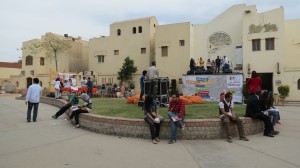
(Photo By: Thoraia Abou Bakr)
Anti-sexual harassment initiative HarassMap said over 60% of sexual harassment takes place on the street.
The initiative recently released an annual report for October 2011 to October 2012. During that period, several initiatives and campaigns fighting sexual harassment have been formed. Some initiatives used art and graffiti to express their point, while others have patrolled the streets to in attempts to prevent harassment. Some of these campaigns are one day activities, while others can last much longer.
“There is no doubt that the increasing number of initiatives eventually leads to reaching our goal of developing a wide sector of society that rejects this phenomenon,” HarassMap’s report said.
While the most prevalent type of harassment is groping, the least common was jokes of a sexual nature, with only 0.4% of victims reporting have been subjected to these jokes. The second most frequent form of harassment was sexual comments with 35.3% of victims facing such verbal remarks.
Most of the perpetrators were men, with only 2.2% reported being harassed by women. Around half of the harassers were young adults, aged between 18 and 29. Almost 40% of them were children under 18 and only 14.5% of harassers were adults 30 years of age or older.
In most incidents in which the perpetrator was described, the perpetrator was using a private car to commit the act.
Around 27% of incidents of harassment were mob harassment, with more than one perpetrator. More than half the victims who faced mob harassment faced the incidents alone, not in groups. Most of the perpetrators in mob harassment were men. In 45.8% of the incidents, it was possible to identify the age of the harassers. Around half of them were children and 45.5% were young adults. Only 3% were adults. Most of the victims of mob harassment are women.
Around 22.7% of mob harassers used motorbikes, 22.7% were schoolchildren and 22.7% exploited protests to carry out mob harassments. On 25 January 2013, 19 cases of women being groped, verbally assaulted or raped were reported in Tahrir Square.
In February, the human rights committee of the Shura Council discussed sexual harassment during protests and called for designating a place for female protesters only. A member of the council from the Freedom and Justice Party said women should not mingle with men in protests. Another member from a Salafi party said women are to blame for the sexual harassment they face. He suggested that women bring rape upon themselves by putting themselves in compromising situations, such as protests.
Most of the victims of sexual harassment took action against the harassment, and 17.4% did not take action. Most responses were insulting harassers or talking to them to convince them not to carry out such behaviour. Around one third of the victims reacted that way, followed by 23.9% who beat the perpetrators.
The report also discussed the psychological effects of harassment on the victims. Around 40% of victims felt rage after the incident, while 17% of victims said they were afraid of the harasser or the environment in which they had faced harassment.
According to HarassMap’s report, 63.1% of victims were harassed in the streets, followed by 19.6 % occurring in public places, then 6.7% in public transport. The least frequent place where people were subjected to harassment is workplaces, only 1.4% of reported incidents.
The report did not show any correlation between harassment levels and the time of day. It indicated that 35% of sexual harassment incidents took place in the morning, 27.5% in the noon and afternoon and 37.5% at night.
Victims who face harassment can report the type of harassment and where it occurred to HarassMap, which documents the incident on the group’s website by marking a red dot on a map of Egypt. HarassMap’s annual report analyses this reported information. Around 270 incidents of sexual harassment were reported between October 2011 and October 2012.
HarassMap was founded in 2010 by experts in the field of sexual harassment and experts from the UN and the World Bank as well as from NGOs.
The anti-sexual harassment initiative has 500 volunteers who raise awareness about sexual harassment among shopkeepers and policemen to convince them to intervene when they witness harassment and help create “safe places”. HarassMap’s research team also provides technical assistance to other groups in other countries that have launched similar initiatives.




